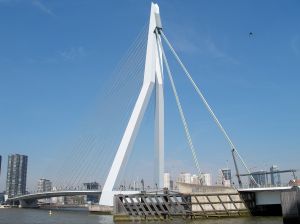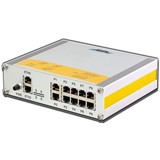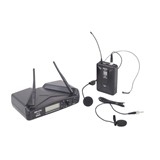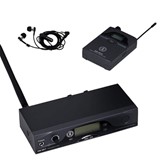But because they can’t always be there in person, one highly intelligent bridge knows what to do when trouble arises: send them an e-mail.
The long spans and slender cables of the Jindo Bridge in South Korea are dotted with a small army of electronic sentinels — tiny wireless sensors and microprocessors that monitor the bridge’s structural health.
The network constantly analyses factors like vibration, wind and humidity, and promptly reports anomalies to a computer that then passes along the news. (As of last week, the bridge said it was just fine.)
Wireless systems like the Jindo Bridge network, a prototype now in its third year of testing, won’t replace human monitoring. But the data collected by the network can help bridge owners make informed decisions, said John W. Wallace, a professor of civil and environmental engineering at the University of California, Los Angeles, and director of the structural/earthquake engineering research lab there.
Traditionally, most systems that monitor structures’ responses to earthquakes or strong winds have been wired ones. But wireless alerts may one day be an alternative.
"Wired monitoring systems are expensive," said Dr. Jerome P. Lynch, director of the Laboratory for Intelligent Structural Technology and an associate professor at the University of Michigan. "You have to route kilometers of wire for power and data."
The wireless systems may also be attractive because of their sophisticated power-management software, which improves battery performance, he said. Sensors can also extend battery life by harvesting power from the sun and the wind — and even from vibrations.
The Jindo Bridge network has 663 wireless sensors, each providing a channel of information at an installation cost of about $100, far less than the thousands of dollars typically needed to install each wired channel, said Dr. B.F. Spencer Jr., a professor of civil and environmental engineering at the University of Illinois at Urbana-Champaign.
Dr. Spencer directs the American-based arm of the bridge project, which also includes the University of Tokyo and the Korean Advanced Institute of Science and Technology. Batteries on the bridge network are expected to last about three years before they need replacement.
Mark Sinclair, an engineer at Degenkolb Engineers in San Francisco who has worked on several wired monitoring systems in buildings, said the wireless systems could find some use after an earthquake, for example, to confirm a lack of damage to a structure.
But Sinclair is skeptical of their general deployment for alerts. Unlike their wired counterparts, "wireless systems don’t have a proven track record yet," he said.
"I don’t know about your wireless signal," he said, referring to telephone service, "but mine is chronically unreliable."
The Jindo network has built-in features to provide backup, Dr. Spencer said. "We’ve developed reliable algorithms to make sure we get the data we need from the sensors," he said. "We store the data locally. If wireless data is interrupted, we can resend it."
Dr. Jennifer A Rice, an assistant professor of civil and environmental engineering at Texas Tech in Lubbock, worked on the Jindo project when she was a doctoral student under Dr. Spencer.
She and her group devised much of the software that conserves power on the network. Instead of having the radios constantly beaming information and using power, the software wakes up sensors for a few minutes so they can collect and analyze data, then switches on the radio to transmit it.
In the future, sensing technologies may add to the scope of wireless monitoring of the infrastructure. At Princeton University, Dr. Sigurd Wagner, a professor of electrical engineering, has developed a sensing skin made of rippled rubber that can be stretched like a membrane across a steel plate.
The skin is covered with a coating that, depending on the initial wavelength of the wavy grating, might emit orange light when an ultraviolet laser shines on it. But when a crack develops — even one that’s imperceptible to the eye — the coating stretches, and the color of the light it emits changes to red. That signals trouble.
Other researchers are also working on structural skins so that engineers can help track the health of buildings. Professor Lynch is developing a sensor skin of carbon nanotubes and polymer that can be used as a coating to help map strain or, with a slightly different chemistry, to measure corrosion in pipelines, aircraft or a whole host of structures, he said.
Professor Wallace of U.C.L.A. says sensors like these skins will have a place in future networks.
"It’s difficult to ascertain if damage at a single point is important," he said, "but if you can look at a larger area, you can make a better judgment."
Noting the aging of the nation’s infrastructure, Professor Wallace said, "If we have thousands of bridges and money to repair only 10 of them, sensors and wireless networks can provide needed data."





